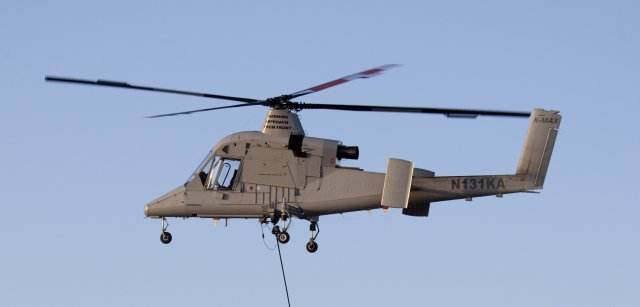 The US Marine Corps made history on December 17, 2011, by flying a cargo UAS in a war zone. Controllers on the ground flew a K-MAX unmanned helicopter from Camp Dwyer, Afghanistan, to Camp Payne in Helmand province, ferrying 3,500 pounds of supplies to fellow Marines.
The US Marine Corps made history on December 17, 2011, by flying a cargo UAS in a war zone. Controllers on the ground flew a K-MAX unmanned helicopter from Camp Dwyer, Afghanistan, to Camp Payne in Helmand province, ferrying 3,500 pounds of supplies to fellow Marines.
Since that inaugural flight, the K-MAX vertical takeoff and landing UAS has flown about 240 missions and hauled more than 750,000 pounds of cargo to Marines. The UAS flies an average of six missions a day — mostly at night — according to a spokeswoman from Lockheed Martin, which builds the helicopter with Kaman Aerospace.
But for soldiers waiting for that capability, it’s unclear when the Army will step into the world of cargo UAS.
The Army has been closely monitoring the Corps’ progress with cargo UAS. In July 2011, it awarded Lockheed $47 million “to provide autonomous technologies for unmanned aerial systems to maximize performance requirements and capabilities with mature technologies.”
The Lockheed spokeswoman said the company has no update on that contract.
Overall, the Army is still working to build a formal programme of record for an unmanned VTOL capability. One company that has long been interested in participating in such a program is Textron/AAI, which has been working with Carter Aviation to convert a manned, four-person rotary-wing aircraft into a UAS able to perform the cargo mission. A spokesman for Textron said “our relationship with Carter continues and we remain interested in the Army’s evaluation of potential technologies.”
The Army’s Maneuver Battle Lab conducted a series of user assessments on the K-MAX last year at Fort Benning, Ga., as part of its Annual Expeditionary Warrior Experiment.
The UAS was able to drop “various payloads using autonomous mode,” said an official at the battle lab at Fort Benning.
Still, an industry source involved in discussions with the Army during the Army Aviation Association of America meeting earlier this month said the service appears to be taking a wait-and-see approach to unmanned lift. Given its other more urgent aviation priorities, such as developing an armed aerial scout and the reset and refit of its rotary wing fleets, the cargo mission isn’t the service’s top priority.
A document provided by the Army said the service is an “active partner” with the Marines, and it is looking for industry to provide cargo UAS solutions in seven to 10 years.
The Corps worked with industry for several years on its unmanned cargo lift program, evaluating the K-MAX as well as Boeing’s A160T Hummingbird, also a VTOL platform. The Marines handed Boeing a stop-work order in December that ended the company’s participation in the program.
Two K-MAX UAS were sent to Afghanistan in November, and weeks later began flying missions. During a quick-reaction assessment last summer, the K-MAX exceeded the Navy and Marine Corps’ requirement to deliver 6,000 pounds of cargo per day over a five-day period, eventually hauling 33,400 pounds of cargo during evaluations.
The Army was at one point considering the A160T Hummingbird for its unmanned cargo lift programme, but Boeing spokeswoman Elaine Brabant said she is aware of no ongoing programme to pursue that interest.
The Army has, however, contracted with Boeing on the ISR front to send two Hummingbirds to Afghanistan equipped with the Autonomous Real-Time Ground Ubiquitous Surveillance Imaging System sensor, developed by the Defense Advanced Research Projects Agency and BAE Systems. Boeing is “currently in the test phase preparing for deployment in June,” Brabant said.
The ARGUS-IS system features a 1.8-gigapixel camera that produces real-time video streams at the rate of 10 frames a second.
In January, the Army released a request for information to industry, looking for a cargo unmanned aircraft system that can deliver cargo up to 300 nautical miles at airspeeds of at least 250 knots with VTOL capability. It must also be able to fly in a variety of harsh weather conditions, operate 24 hours a day, and carry 5,000 to 8,000 pounds, according to the document.
The Army’s Logistics Initiatives Group, which is spearheading the effort, held an industry day in February to better explain its thinking to potential bidders. Much like the Army’s current focus on equipping and training units to fight at the brigade level and below, the service’s unmanned cargo request prioritizes operations conducted at that level. The document asks for the platform to be able to be “supported by a minimal ground control element located at brigade or lower,” as well as the “ability to accommodate networking that allows authenticated users to control multiple platforms.”
Photo: Lockheed Martin
Source: Army Times
